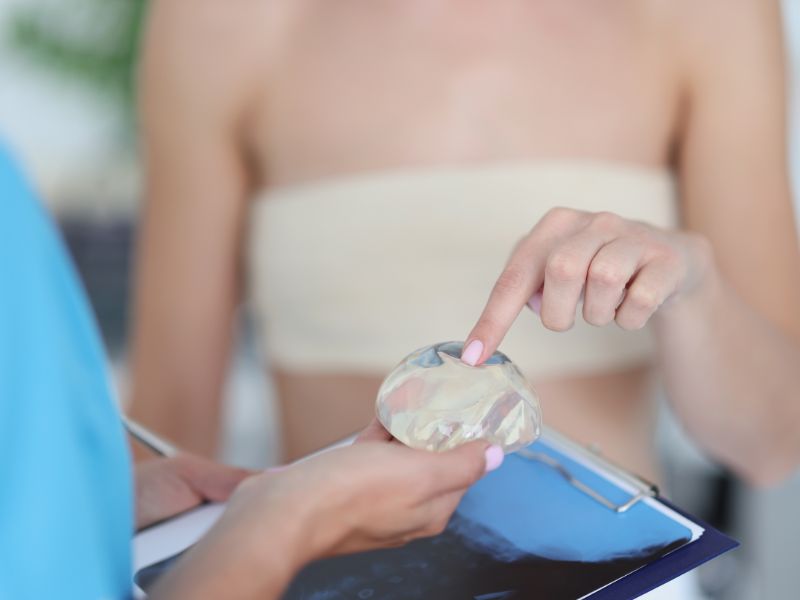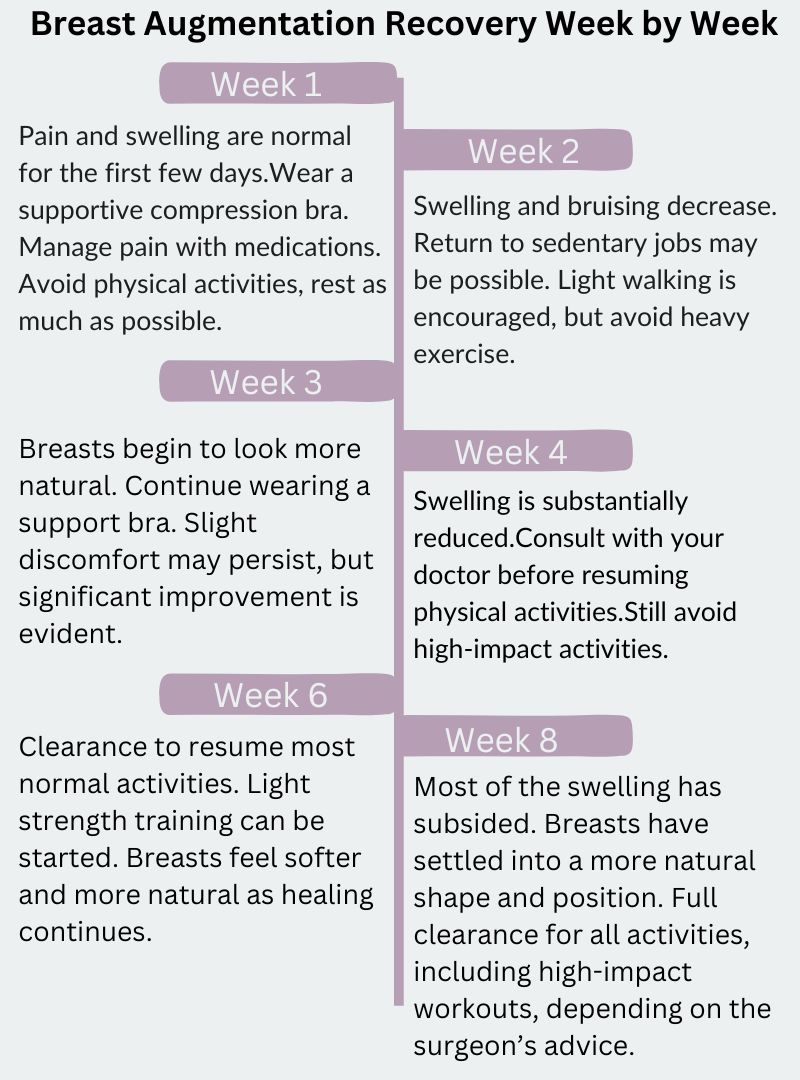Breast Augmentation Recovery Week by Week

Breast Augmentation Recovery Week by Week
As a cosmetic surgeon, I have performed countless breast augmentation procedures, and I know how vital the recovery process is for achieving the best results. Breast augmentation surgery is one of the most common cosmetic procedures designed to enhance the size and shape of a woman's breasts. Although the surgery is relatively straightforward, recovery is crucial to achieving optimal results.
Understanding what to expect each step of the way will ensure a smoother physical and emotional experience. This week-by-week recovery guide will provide an in-depth look at the healing process and offer helpful tips to aid you in your breast augmentation journey.
Preparing for your breast augmentation recovery experience
Before undergoing breast augmentation, it's essential to prepare for the recovery phase. Adequate preparation will help you feel more in control, reduce stress, and ensure your healing progresses smoothly. Here are some tips to get ready:
Set Up a Comfortable Recovery Space: After surgery, you will spend the first few days resting. Set up a reclined area with plenty of pillows to support your back and shoulders.
Arrange for Assistance: For at least the first week after surgery, you'll need someone to help with everyday tasks such as cooking, cleaning, and childcare.
Stock Up on Recovery Essentials: Comfortable clothes, such as loose shirts that button up the front and compression garments, are essential for the early days of recovery. Light, healthy meals and hydrating fluids on hand will also aid healing.
Now that you're prepared, let's dive into what to expect each week during your recovery.
Breast Augmentation Recovery Timeline

1 Day after surgery
Immediately after surgery, you will feel sore and experience some discomfort. This is completely normal. The breasts will look swollen, and there will likely be some bruising around the incision area. Patients commonly report tightness in the chest as the skin and muscles adjust to the implants.
You'll be fitted with a surgical bra or compression garment, which helps reduce swelling and support your new breast shape. Prescription pain medication will be provided to keep discomfort manageable. It's crucial to rest and avoid any physical activity. Additionally, I recommend sleeping at a 45-degree angle (either in a recliner or propped up with pillows) to minimise swelling and make it easier to get up.
2 Days after surgery
You'll still experience soreness and swelling by the second day, but pain medication will make it manageable. If you had surgical drains placed, follow my instructions for their care closely. Swelling may continue, but this is normal. Some patients report a tight or burning sensation in the chest as the body adjusts to the implants, especially if placed under the muscle.
At this point, light movement, such as walking around the house, is encouraged to improve circulation and prevent blood clots. Avoid strenuous activities or lifting your arms above your head.
3 Days after surgery
On day three, you should start feeling slightly better. While there will still be swelling and soreness, you will be more mobile. Some patients feel comfortable enough to switch from prescription painkillers to over-the-counter options. Still, it's important to gauge how your body feels and not rush this transition.
You'll still need to avoid upper-body movements such as lifting, pushing, or pulling. While you might feel better, it's crucial to continue resting to avoid complications and ensure proper healing.
1 Week after surgery
You'll notice a marked improvement by the end of the first week. Swelling and bruising will still be present but much reduced. Most of my patients feel well enough to return for a follow-up appointment at this point, where I will assess how the incisions are healing and check for any signs of complications.
During this appointment, I may recommend starting breast massages to help the implants settle and promote a more natural shape. This is also the point when you can likely reduce the use of strong painkillers. Most patients with sedentary jobs can return to work around this time, though it's important to continue avoiding heavy lifting or strenuous physical activity.
2 Weeks after breast augmentation surgery
Two weeks after surgery, you'll start feeling much more like yourself. Swelling will have decreased significantly, and most bruising will have subsided. At this point, I may advise transitioning from the surgical bra to a more comfortable support bra, but it's important to check with me before making any changes.
Light walking remains the only recommended form of exercise. More strenuous activities such as running or strength training should still be avoided. Many patients with office jobs are fully capable of returning to work, though I still recommend taking things slowly.
3 Weeks after surgery
At the three-week mark, you'll continue to see improvement. The breasts will look more natural, and the swelling will be reduced even further. There may still be some minor discomfort, but this should be minimal. I will continue to monitor your progress to ensure everything is healing as expected.
Support bras should still be worn consistently, and your incisions should heal well. If there are any concerns about how the breasts are settling or any signs of complications, this is the time to address them with me.
4 Weeks after surgery
By four weeks, many patients report feeling almost fully healed. While some residual swelling might persist, the breasts will have started to settle into their new shape. Most of the discomfort should have passed by now, and you may feel ready to resume light physical activities.
While walking is still encouraged, high-impact activities and exercises that involve your chest muscles should be avoided for a few more weeks. I will likely schedule a follow-up to check on your progress.
6 Weeks after surgery
You're nearing the end of your recovery journey at the six-week mark. Most patients are cleared to resume moderate exercise and even light strength training. However, heavy lifting or high-impact workouts should still be avoided.
Your breasts will continue to settle, feeling softer and more natural. Any scarring from incisions will begin to fade, although it may take longer to completely blend in with your skin tone.
8 Weeks after surgery
By two months post-surgery, you'll feel almost entirely recovered. Most of the swelling should be gone, and your breasts will appear more natural in shape and position. Any minor discomfort will have subsided, and if you experienced any numbness or loss of sensation, it may begin to improve now.
You will likely be cleared for full activity, including high-impact workouts, but as always, check with me before resuming any rigorous exercise.
12 Weeks after breast augmentation
By three months, most patients feel fully recovered and back to their routine. The breasts will have settled into their final position, and any remaining swelling will be virtually unnoticeable. At this point, you can enjoy the full results of your surgery.
If you have concerns about scarring, we can discuss treatments to reduce their appearance, such as silicone scar sheets or creams. This is also a good time to assess the overall outcome and ensure you are happy with the results.
6 Months after breast augmentation
Six months after surgery, the final results of your breast augmentation will be visible. The breasts will have softened and taken on a completely natural appearance. Any scarring will continue to fade over time, and you'll be fully healed with no physical limitations.
At this point, most patients experience a significant boost in self-confidence and are thrilled with their new look.
FAQ: Breast augmentation recovery
When should i schedule my breast augmentation?
The best time to schedule your breast augmentation is when you have ample time to rest and recover without major work or life commitments. Most patients take at least one to two weeks off work, with some opting for more time depending on their job's physical demands.
What is the fastest way to recover from breast implants?
To recover quickly, follow your surgeon's instructions diligently, wear compression garments, stay hydrated, and avoid strenuous activities. Gentle walking can improve circulation and promote faster healing.
Can i return to work 3 days after breast augmentation?
While some patients with very sedentary jobs might return to work within a few days, waiting at least one week is generally recommended before resuming work. Listening to your body and allowing yourself enough time to heal is essential.
How painful is breast augmentation recovery?
Most patients experience discomfort rather than intense pain. The tightness and soreness typically subside after the first week, with most pain managed effectively with prescribed medications.
What are good breast augmentation recovery tips?
Wear Your Surgical Bra: This helps support healing and reduces swelling.
Take Prescribed Medication as Directed: Keeping pain under control will make your recovery more comfortable.
Stay Hydrated and Eat Light: Nutritious meals and hydration support healing.
Rest and Avoid Strenuous Activity: Give your body the time to heal without pushing yourself too soon.
In summary, breast augmentation recovery is a journey that requires patience and proper care. Following this guide and your surgeon's advice, you'll be well on your way.
Recovery in Turkey
If you're undergoing breast augmentation surgery in Turkey, your first week of recovery will be very similar to what's described above. Most patients remain in the country for at least one-week post-surgery to ensure a safe recovery and attend follow-up appointments. I recommend staying in a nearby hotel or recovery clinic to rest, and you'll have easy access to follow-up care. After your first post-op visit, you should be cleared to travel home and continue your recovery.
 Turkish
Turkish